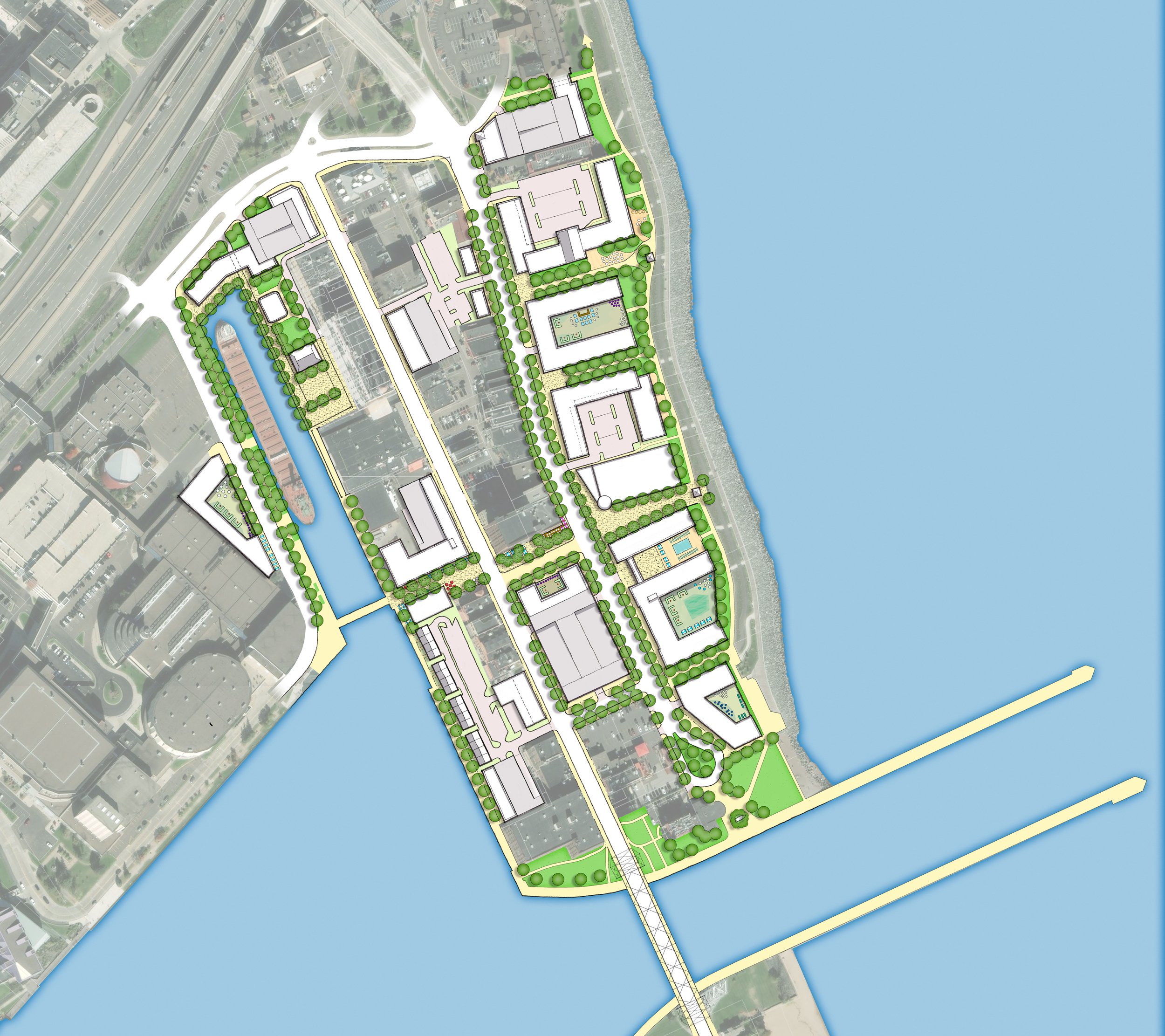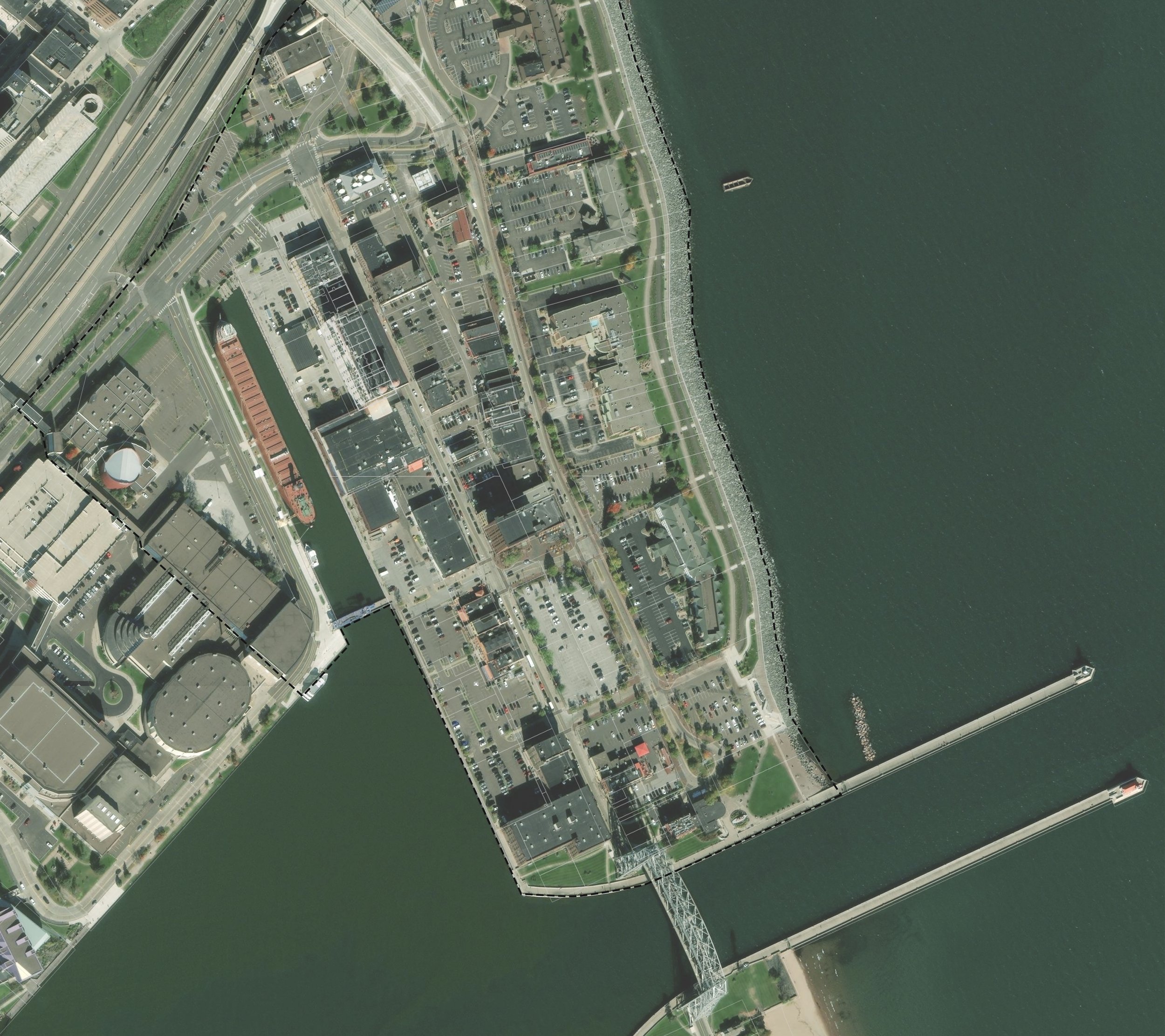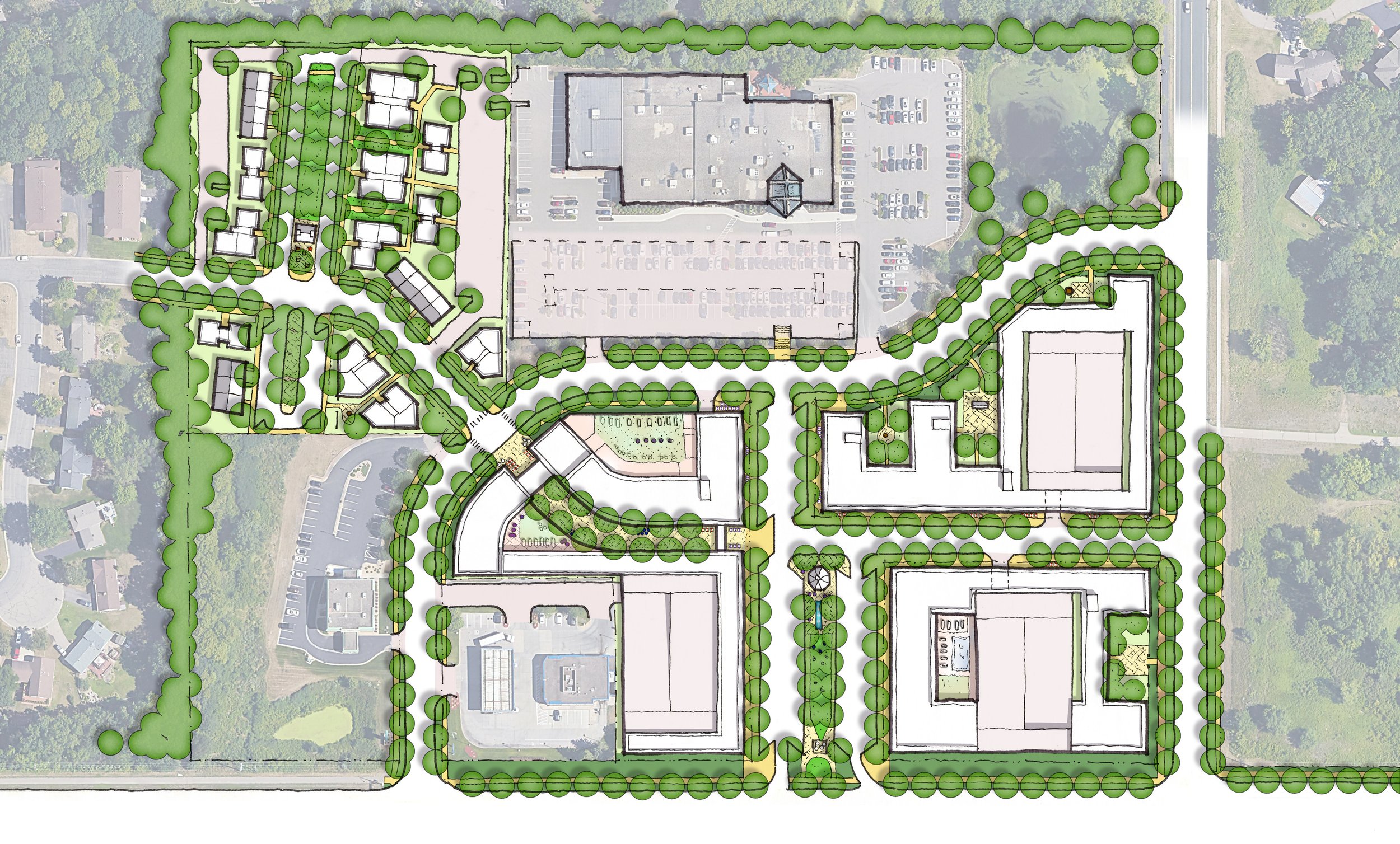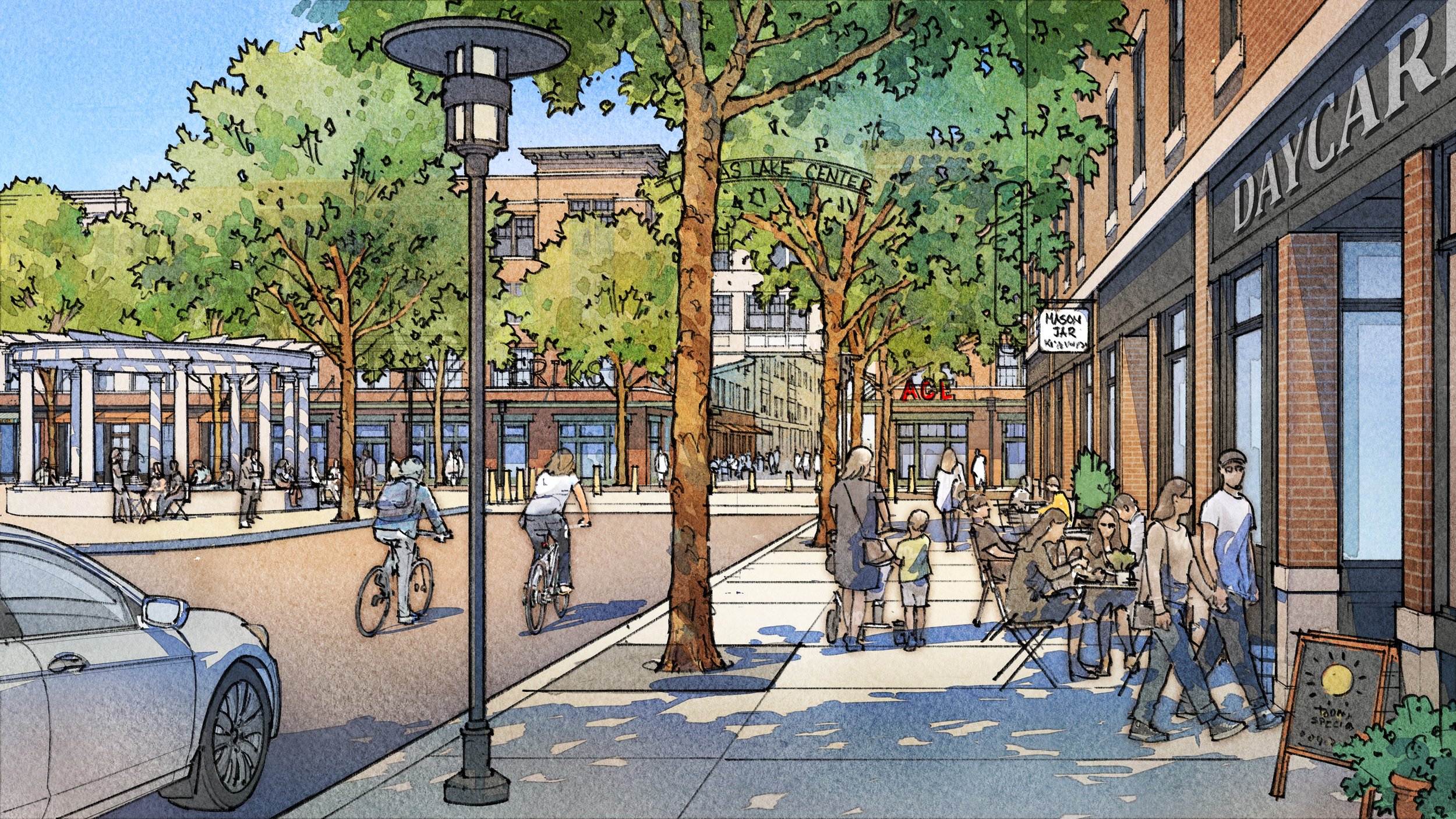Canal Park
How can we transform a cherished destination in Duluth to better support pedestrians?


Canal Park is a cherished tourist destination along the shores of Lake Superior in Duluth, Minnesota where it meets the mouth of the Saint Louis River. Despite its status as an icon of the Great Lakes region, we believe this underutilized asset could be so much more. This installment in the “Back to the Future” series explores an alternative future for what Canal Park could be. One that shows how it could grow to house more full-time residents, to support more jobs, and to bring more economic prosperity to the region as a whole – while embodying new urbanist principles.
We’re believers that we can do better at building and fostering great places for people in Minnesota. This is the second installment in an on-going series of redevelopment studies titled “Back to the Future”, where we bring together ideas for transforming places that both harken back to a less auto-centric, traditional approach to neighborhood design, while weaving in a vision for the future of people-centered Minnesota developments. We believe there are ways to build places today that are attractive to people and businesses, fiscally smart for our municipalities, and gentler on the planet. The principles of New Urbanism inform this work and we think more pedestrian-friendly, mixed-use environments just make common sense. Each concept walks you through the thinking of an Urban Designer (Cardo) & Developer (Good Neighbor Homes) as they try to create places worth writing home about.
The Lakewalk along the eastern edge of Canal Park.
Canal Park is 70-acre peninsula located just south of downtown Duluth. At its southern end, the famous Aerial Lift Bridge rises above the skyline, providing access from Lake Superior to ports in both Minnesota and Wisconsin as well as a fun attraction for visitors to watch go up and down as huge freighters pass by. While connected to the rest of Duluth on its northern and western edges, the area feels isolated from the rest of the city, with Interstate-35 slicing between the two. This former industrial warehouse district had fallen into disrepair and was even used as a dumping ground for decades. This changed in the 1970s and 80s as business owners and the City saw the potential for the area. Hotels and restaurants replaced vacant buildings and the lakefront’s garbage piles were cleared to make way for boardwalks and paths. A substatinal improvement, no doubt! Despite economic revitalization in the area, it is still dominated by impervious pavement with a focus on moving and parking vehicles and not a pedestrian’s experience. We acknowledge that cars exist, and must be considered, but we are focused on what that experience is like once you park the car for the weekend. We believe a second renaissance is not only needed, but now is an opportune time to start. Grassroots efforts to reimagine I-35 are underway, a proposed high speed train connection between the Twin Cities and Duluth is one step closer to reality, and the region is finally reversing decades of population decline.
A vision for the future of Canal Park.
We are thinking big about Canal Park and what the area might look like in a generation. At the same time, we are using the constraints that exist already such as parcel ownership patterns, current construction costs, and placing a high value on the preservation of cultural institutions (like Grandma’s). This theoretical exercise is not about an exact number of hotel keys, or a specific breakdown of multi-family for rent or sale, rather we are most concerned about the building form and what is attainable. We are not proposing a specific program, but instead one potential vision for the future.
So where do we start? A rational place to begin is with publicly-owned land, in particular land owned by the City of Duluth. Utilizing a district parking strategy, where the City builds a public garage, charging for individual parking spaces or leasing spaces to large businesses, would unlock development potential. The existing parking lot between Buchanan and Morse Streets is partially owned by the City, centrally located, and would provide enough space to build a substantial garage. On the ground floor the garage would be wrapped by commercial spaces, creating an active and inviting edge to the street for pedestrians, where none exists today. The northern edge of the garage would include a mixed-use building, helping to create a new plaza in the heart of Canal Park. Other, surrounding parking lots could then become new businesses, townhomes, hotels, and apartments. New residential units, hotel rooms, or restaurants could overlook an improved Lakewalk that wraps all 3 sides of the peninsula. What has previously a drain on the City budget could instead contribute to the City budget while creating a safer, more beautiful place for people.
As the larger parcels near the southern end of Canal Park redevelop, other small infill lots could become 2-3 story buildings that are appropriately scaled to complement the older buildings in the neighborhood. That development would bolster local developers and could happen more quickly than other projects.
Proposed Residential Units:
1,516 Units
Proposed Non-residential Square Footage:
110,000 SF
Proposed Off-street Parking Spaces:
1,544 Spaces
Taxable Value Created:
$350 Million
Once more housing and commercial buildings are developed the hotel owners east of Canal Park Drive might see that their parcels are underutilized. Larger hotels with more rooms, could be reoriented to both harness Lake views and make Canal Park Drive a two-sided, vibrant main street. A small parking lot at the intersection of Canal Park Drive and Railroad Street could become a second public parking garage, helping to alleviate parking concerns for new visitors and residents. This would be the opportunity to create more passages and paths from Canal Park Drive to Lake Superior.
While a stroll along Lake Superior or beside the Canal is pleasant, connections from the western bay to the Lake could be improved. An improved pedestrian connection from the Duluth Convention Center all the way to Lake Superior, with a series of plazas, a new venue, and commercial spaces will rejuvinate Canal Park.
We acknowledge this is a theoretical exercise, a real development process should absolutely include the community, its voices, and have genuine community engagement. Generational change is slow, but possible here. We believe Canal Park should be oriented towards pedestrians, have a mix of uses that create a livable neighborhood, and be dense in order to conserve more of our beautiful natural environment, like the North Shore of Lake Superior. At the same time, what is proposed is achievable. It follows realistic parking ratios, envisions building that could support hotel, housing units, or flexible office space, and it preserves the vast majority of buildings that exist today. No proposed building is over 5 stories, which means the Aerial Lift Bridge will tower over Canal Park as it has done for over a century.
An aerial rendering showing a vision for the future of Canal Park.
Thomas Lake Town Center
What does the future hold for our aging strip malls and suburban commercial centers?


What’s the first thing you notice about the existing aerial of the left? What’s the first thing you notice about the site plan on the right? We think the contrast is clear. One is mostly used to store cars, with only a few spots for enjoyment or relaxation, tucked amid huge swaths of pavement. The other is a vision for a dynamic place where you’ll find dozens of spaces that were designed for people to spend time with friends and neighbors. Parking is tucked away amid a varied, active streetscape.
We’re believers that we can do better at building and fostering great places for people in Minnesota. This is the first installment in what will be an on-going series of redevelopment studies titled “Back to the Future”, where we bring together ideas for transforming places that both harken back to a less auto-centric, traditional approach to neighborhood design, while weaving in a vision for the future of people-centered Minnesota developments. We feel that in some ways, our approach is a bit paradoxical to the conventional wisdom of the development industry today, which sees parking as the primary way to attract high value businesses and customers to a site, neighborhood, or a city at large. We’d like to put forth an argument, by way of these case studies, that there are ways to build places today that are attractive to people and businesses, fiscally smart for our municipalities, and gentler on the planet. In this series, we will take everything from no-name strip malls to iconic tourist destinations and reimagine what could be possible on these sites. The principles of New Urbanism inform this work and we think more pedestrian-friendly, mixed-use environments just make common sense. Each concept walks you through the thinking of an Urban Designer (Cardo) & Developer (Good Neighbor Homes) as they try to create places worth writing home about.
Thomas Lake Center and the surrounding commercial land encompass about 27 acres at the corner of Thomas Lake Road and Cliff Road in Eagan, Minnesota. The center is well located, just one mile east of Interstate 35 and a mile north of Lebanon Hills Regional Park, the crown-jewel of parks in the southern part of the Twin Cities metro area. The site includes the original 80s strip mall, some outlots that house a gas station and auto repair shop, and adjacent parcels that include medical offices and a Lifetime Fitness location. More than half the site is dedicated to surface parking lots, some of the storefronts are vacant, and not a single residential unit is located on site. To further complicate redevelopment, a gas line serving the region occupies a 100-foot easement that slashes through the western side of the site. With the terminus of the Gold Line and D Line just a few miles away, this location is a perfect example of Transit-Ready Development, where the addition of one or two new stops can enhance an existing and expanding Bus Rapid Transit network.
Our new vision is centered around the not-so-new concept of a main street and town square, fronted with retail, services, and restaurants that generate all day activity.
The concept, as shown above, adds considerable value across various facets of the built environment. It adds 535 homes, in a variety of types (for sale/for rent, walk-up, townhome) to an area that is largely low-density and to a region that is suffering from a lack of new housing supply, and especially of affordable units. Any development of this size can and should include a sizable number of affordable units. We modeled 1,066 parking stalls that only rely on a 10% shared-use system where as residents leave for the day’s work, shoppers can fill in and vice versa. Each unit has a dedicated off-street parking stall and the commercial spaces have 4 stalls/1,00 square feet. Providing ample, convenient parking for the residents and businesses is still critical for the overall success of this development. With the large 6-lane Cliff Road and the reduced car trips from having most of your daily/weekly needs met on-site, the increased traffic volume will be modest and easily absorbed by the current roadway. From the City of Eagan’s perspective, this development is a fiscal no-brainer. On the exact same acreage, they will generate upwards of $200M in additional taxable value, with very modest increases in city infrastructure (e.g. waste & water) and service (e.g. police, fire, etc.) responsibilities.
Number of Residential Units:
Current 0
Proposed 535
Commercial Square Footage:
Curent 22,000 SF
Proposed 110,000 SF
Number of Parking Spaces:
Curent 756 Spaces
Proposed 1,066 Spaces
Open Space:
Curent 0 Ac.
Proposed 0.7 Ac.
Density:
Curent NA
Proposed 21 units/acre to 46 units/acre
What about the effects to the enivornment? An analysis of conventional townhomes, walk-up and corridor apartments, and strip commercial built within 3 miles of the site indicates that in order to match the equivalent proposed number of units and commercial square footage, an area of 52 acres be required. This site plan achieved the same number of units and commercial square footage in an area less than 1/3 the size, or 15.5 acres. This is what responsible stewardship of the environment looks like, creating better places for humans, and preserving more land for natural habitats. Furthermore, the proposed site plan only increases the the impervious surface area of the site by 13%, while introducing open spaces, plazas, and parks, something that is completely lacking on site today.
Approaching a conceptual development like this could lead one very quickly to a fantasy land of possibilities, so we established some pretty clear and practical constraints from the outset. For starters, this isn’t an overnight redevelopment that happens all at once. We anticipate a 10-15 year redevelopment timeline where some final version of the site is completed over time, in phases, allowing existing businesses to transition spaces, grow, or bring in new tenants, both residential and commercial, and to help minimize the interruption of business. We assume some of the current commercial tenants relocate to vacant lots along the same corridor (e.g. auto repair shop), others stay because they’re large corporations that own their land and building (e.g. Lifetime Fitness) and others that stay but move out of the old retail strip-center and into the new Town Center retail spaces (e.g. restaurants, bike shop). Lastly, each of the building and street components we’ve modeled are proven concepts that work in places around the country. Townhomes, first-floor retail, mixed-use multi-family buildings, and parking structures are all essential ingredients of place that we’ve simply composed differently here. For the complete development budget click here.
Developments like this don’t happen overnight and they aren’t accomplished in a vacuum on the internet, without community input and engagement, but they are possible and the benefits of creating places like Thomas Lake Town Center are immeasurable. These types of shopping centers aren’t unique to Eagan or Minnesota, your community likely has a similar shopping center, too. A better future, using lessons from the past, can transform these underutilized properties into the heart of the community.








